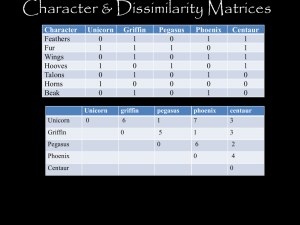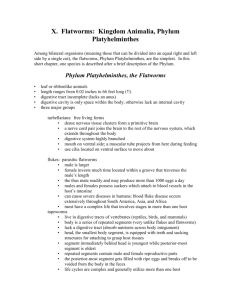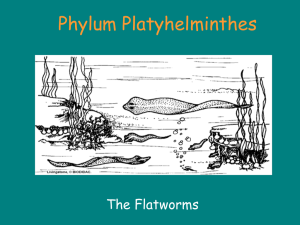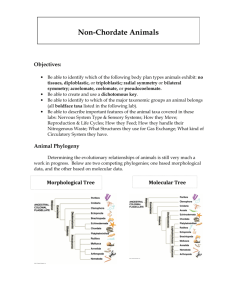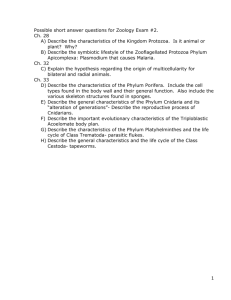The simplest of metazoan phyla: 'Parazoa'
advertisement
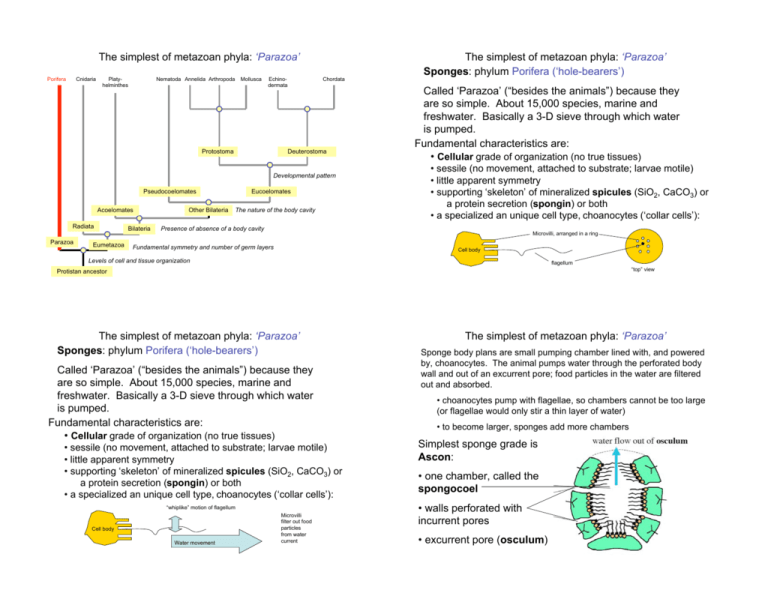
The simplest of metazoan phyla: ‘Parazoa’ Porifera Cnidaria Platyhelminthes Nematoda Annelida Arthropoda Mollusca Echinodermata Protostoma Chordata Deuterostoma Developmental pattern Pseudocoelomates Acoelomates Radiata Parazoa Eumetazoa Bilateria Other Bilateria Eucoelomates The nature of the body cavity The simplest of metazoan phyla: ‘Parazoa’ Sponges: phylum Porifera (‘hole-bearers’) Called ‘Parazoa’ (“besides the animals”) because they are so simple. About 15,000 species, marine and freshwater. Basically a 3-D sieve through which water is pumped. Fundamental characteristics are: • Cellular grade of organization (no true tissues) • sessile (no movement, attached to substrate; larvae motile) • little apparent symmetry • supporting ‘skeleton’ of mineralized spicules (SiO2, CaCO3) or a protein secretion (spongin) or both • a specialized an unique cell type, choanocytes (‘collar cells’): Presence of absence of a body cavity Microvilli, arranged in a ring Fundamental symmetry and number of germ layers Cell body Levels of cell and tissue organization flagellum “top” view Protistan ancestor The simplest of metazoan phyla: ‘Parazoa’ Sponges: phylum Porifera (‘hole-bearers’) Called ‘Parazoa’ (“besides the animals”) because they are so simple. About 15,000 species, marine and freshwater. Basically a 3-D sieve through which water is pumped. Fundamental characteristics are: • Cellular grade of organization (no true tissues) • sessile (no movement, attached to substrate; larvae motile) • little apparent symmetry • supporting ‘skeleton’ of mineralized spicules (SiO2, CaCO3) or a protein secretion (spongin) or both • a specialized an unique cell type, choanocytes (‘collar cells’): “whiplike” motion of flagellum Cell body Water movement Microvilli filter out food particles from water current The simplest of metazoan phyla: ‘Parazoa’ Sponge body plans are small pumping chamber lined with, and powered by, choanocytes. The animal pumps water through the perforated body wall and out of an excurrent pore; food particles in the water are filtered out and absorbed. • choanocytes pump with flagellae, so chambers cannot be too large (or flagellae would only stir a thin layer of water) • to become larger, sponges add more chambers Simplest sponge grade is Ascon: • one chamber, called the spongocoel • walls perforated with incurrent pores • excurrent pore (osculum) The simplest of metazoan phyla: ‘Parazoa’ • sponges are very loosely organized, little or no coordination • can be mechanically or chemically broken down and can reform! • cells are totipotent -- single cell of any type can form new animal Diploblastic animals CNIDARIANS: phylum Cnidaria (“thread-bearers”) About 9,000 species, most in marine habitats (a few in fresh water) • TISSUE level of organization: cells are organized into specialized tissues, sometimes approaching organs (groups of different tissues with common function) • DIPLOBLASTIC --two fundamental cell layers • Radial symmetry around the oral-aboral axis. • Support via hydrostatic skeleton (trapped water) or viscoelastic skeleton. Hydrostatic: deformable but not compressible Viscoelastic: deformable but “springy” (elastic), not compressible • Sessile and attached, or floating in water -- some swim fairly actively (have contractile “muscle” cells, but these don’t derive from mesoderm) Diploblastic animals Diploblastic animals Cnidarians have their own characteristic and unique cell type, the cnidocyte. Cnidocytes are stinging cells with a special organelle, the nematocyst. Cnidocil “trigger” A closer look at a discharging nematocyst shows sophisticated mechanism: • Rapid projection; thread is ‘fired’ into the target at high speed cnidocyte • numerous barbs help dig into target and fix the thread into place Nematocyst, coiled inverted in ‘vacuole’ filled with toxin • propulsion is from highpressure toxin, which is injected into target When the cnidocil trigger is touched, or if certain chemicals are present, the nematocyst discharges by rapidly inverting outwards under pressure: • can be very powerful; hemolytic or neurotoxic; may be painful or fatal to humans in a few species (box jellies from Australia) Diploblastic animals Diploblastic animals Cnidarians have two basic body forms, which are quite similar. Both built around two cell layers and hydrostatic or viscoelastic skeleton. Polyp form Combined mouth and anus • sessile, attached to substrate at aboral end tentacles • if mouth is closed, water is trapped in the gastrovascular Gastrovascular cavity cavity • circular and longitudinal ‘muscles’ put pressure on trapped water Polyp form Oral end • sessile, attached to substrate at aboral end Epidermis Largely acellular mesoglea Gastrodermis Aboral end • tentacles catch food; simple nerve net and some coordination Cnidarians have two basic body forms, which are quite similar. Both built around two cell layers and hydrostatic or viscoelastic skeleton. • if mouth is closed, water is trapped in the gastrovascular cavity • circular and longitudinal ‘muscles’ put pressure on trapped water • Water is deformable but not compressible -- basis of hydrostatic skeleton (can change shape but not volume) -- gastrovascular cavity works this way. • A viscoelastic skeleton is deformable and noncompressible -but it is also elastic and resumes original ‘relaxed’ shape when force is removed (it is ‘springy’) -- mesoglea works this way. • tentacles catch food; simple nerve net and some coordination Diploblastic animals Cnidarians have two basic body forms, which are quite similar. Both built around two cell layers and hydrostatic or viscoelastic skeleton. Polyp form • sessile, attached to substrate at Evenend these very simple animals aboral have social behavior: in some species, clonal colonies form by asexual division, • if mouth is closed, water is and fight territorial battles with other clone groups. trapped in the gastrovascular cavity • circular and longitudinal ‘muscles’ put pressure on trapped water • tentacles catch food; simple nerve net and some coordination Diploblastic animals The other basic cnidarian body form is the free-swimming medusa, obtained by ‘flipping over’ the polyp: • swims by contracting muscles around gastrovascular cavity, pushing against water • springy (viscoelastic) mesoglea helps sustain rhythmic swimming • tentacles may be very long Diploblastic animals Three major classes of cnidarians: Hydrazoa (hydra, etc.) • Complex life cycle, always with polyp form; sometimes medusa • Polyp is the ‘dominant’ stage. • Sometimes colonial with many specialized individuals (clones) form the complete ‘animal’ (“Portugese man-o-war”). Diploblastic animals Three major classes of cnidarians: Diploblastic animals Three major classes of cnidarians: Schphozoa (“true” jellyfish); free-swimming Anthozoa (sea anemones and corals) Complex life cycle, medusa stage is dominant; feed on animals. • only have the polyp stage; can be structurally fairly complex; mesoglea more cellular than in Hydrozoans and Scyphozoans Some can get very large (over a meter in diameter). • often symbiotic with unicellular algae • corals secrete a calcium carbonate “house”; coral reefs are largest structures made by any form of life Diploblastic animals Next: groups with three fundamental cell layers and bilateral symmetry: triploblastic animals Three major classes of cnidarians: Reef corals reproduce sexually by spawning; simultaneous release of sperm and eggs on just one to three nights per year! This is their dispersal stage: Triploblastic animals have a third primordial cell layer, mesoderm, and tissues are compounded into organs and organs systems. Also, all triploblastic animals have a fundamental bilateral symmetry (not radial symmetry); often called ‘bilaterians’ or Bilateria. Within bilaterians, major clades (lineages) are defined by • changes in body cavities (presence, arrangement) • patterns of development (especially how mesoderm and body cavities are formed) Next: groups with three fundamental cell layers and bilateral symmetry: triploblastic animals Triploblastic animals Next: groups with three fundamental cell layers and bilateral symmetry: triploblastic animals…first the flatworms, or Platyhelminthes Triploblastic animals FLATWORMS: phylum Platyhelminthes FLATWORMS: phylum Platyhelminthes 15,000-20,000 species, in most habitats (marine, freshwater, moist terrestrial, often parasitic). Major characteristics: Basic body plan includes these features: All of the fundamental bilaterian traits: TRIPLOBLASTIC, ORGAN and ORGAN SYSTEM level of organization, BILATERAL SYMMETRY • body solid (no cavities: ACOELOMATE • motile (except some parasitic forms); mesoderm provides muscle tissue and improved locomotion compared to diploblasts • hence cephalized • no circulatory system (animal must be thin so diffusion will work) • Flat (see above) ectoderm Gastrovascular cavity mesoderm “brain” Mouth/anus • gut with single opening, usually branched to get close to all parts of body • gut serves for digestion, nutrition, gas exchange, waste removal • feed on animal tissue (scavenger, predator, parasite) • often hermaphroditic: contains both male and female gonads; usually crossfertilize Endoderm (gut) Triploblastic animals Triploblastic animals FLATWORMS: phylum Platyhelminthes FLATWORMS: phylum Platyhelminthes Three major classes: Three major classes: Turbellaria (free-living flatworms), relatively unspecialized; probably similar to ancenstral flatworms. “Planarians” are familiar examples. Trematoda (flukes): parasitic and modified for this life style with a ventral and oral adhesive disc. • Apparently ancestral forms were primarily parasites of molluscs (like snails), with subsequent evolution of other hosts, especially vertebrates • Very diverse and often highly specialized (typical of parasites; co-evolution of host and parasite) Other turbellaria live in marine habitats (like these): • Life cycles frequently complex, with multiple host species (at least one life stage is usually a mollusc). Triploblastic animals Triploblastic animals FLATWORMS: phylum Platyhelminthes FLATWORMS: phylum Platyhelminthes Examples of trematode life cycles Examples of trematode life cycles • Clonorchis (liver fluke) lives in liver and bile ducts of mammals (including humans); its life cycle passes from snails to fish to mammals: Adult lays eggs Immature fluke migrates to liver, matures Mammal eats fish, cysts release immature flukes Eggs (passed in feces to water) First larval stage hatches, infects snail Second larval stage penetrates fish skin and encysts in muscle • Schistosoma (cause of schistosomiasis) lives in blood vessels in intestine, bladder, etc. A major human disease problem in the tropics; sometimes called ‘snail fever’ because intermediate host is a snail: Mature adults mate and lay many eggs Cercaria migrates to internal organs Cercaria larvae leave snail, swim in slowmoving water, penetrate final host’s skin Eggs (passed in feces to water) Ciliated larval stage hatches, infects aquatic snail Triploblastic animals FLATWORMS: phylum Platyhelminthes Examples of trematode life cycles • Leucochloridium is a parasite of birds and amber snails. It lives in the bird’s gut; eggs are excreted in droppings, and snails eat them. In the snail, Leucochloridium produces large larvae-containing sacs that penetrate the snail’s tentacles….and pulsate to attract birds!! Triploblastic animals FLATWORMS: phylum Platyhelminthes Third major class is Cestoda (tapeworms) • Parasites of vertebrates, most highly specialized flatworms; one or more intermediate hosts • no gut; all nutrition absorbed from host • ‘head’ modified as a holding organ (scolex), attaches to host’s gut lining (animal resides inside intestinal lumen). • almost all of body is devoted to reproductive units called proglottids • some tapeworms are harmful but many are co-evolved with hosts and do little damage Triploblastic animals Typical mature tapeworm (from humans, other mammals, birds) -- can be 3-4 meters long
